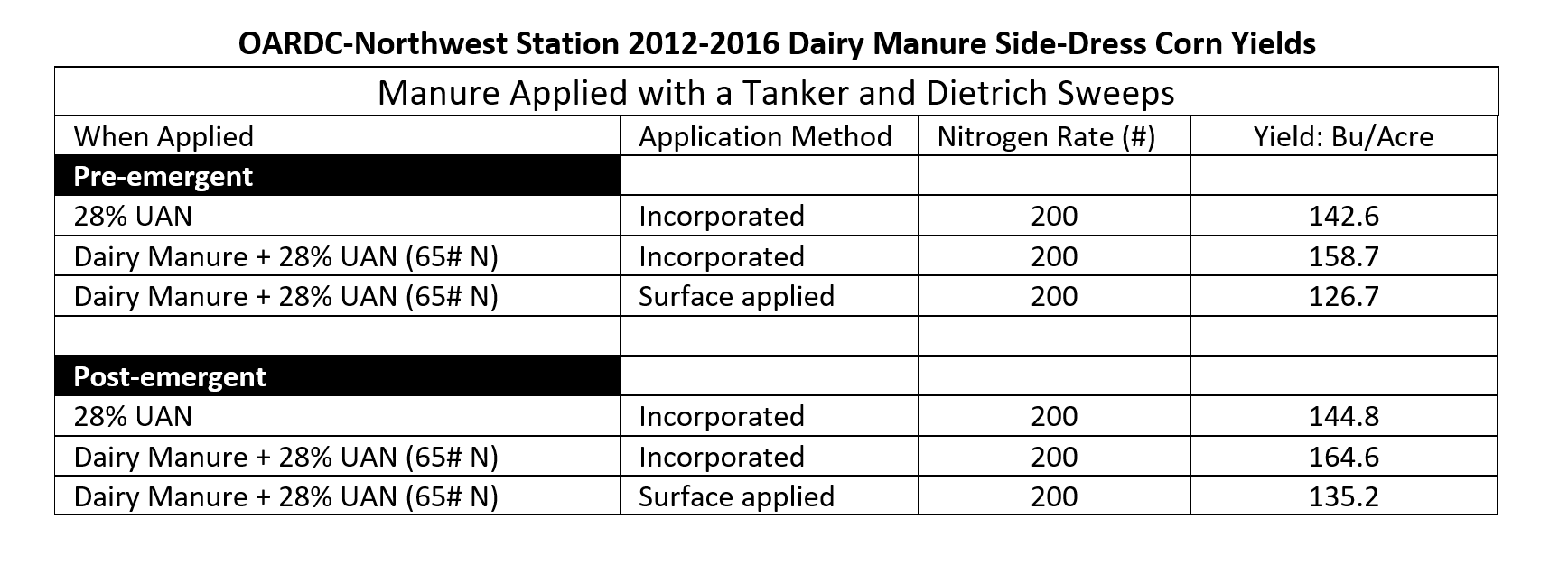Capturing Nutrients from Dairy Manure
The land application of manure, milking parlor water, outdoor lot runoff and silage leachate is a necessary part of dairy farming. Manure transport and application is a significant expense on dairy farms that can easily approach $125 to $150 per cow annually.
The best utilization of dairy manure is to apply the manure to a growing crop. Examples include fall fertilization of wheat, application to newly planted double crop soybeans to spur germination and emergence, application to sorghum/sudan grass to stimulate emergence and growth or regrowth after a cutting, or as a stimulate between cuttings of forages. Each of these applications captures the nitrogen in the manure along with many of the other nutrients. Applying manure to growing crops helps gain more revenue from the manure.
The application of manure to corn as a side-dress source of nitrogen has been the focus of research at the Ohio Agricultural Research and Development Center’s Northwest station. Over five crop seasons dairy manure was both incorporated and surface broadcast into pre-emergent and post-emergent corn plots and compared to 28% UAN for yield. In these research plots the dairy manure was applied at 13,500 gallons per acre and contributed 135 pounds of available nitrogen. Each corn side-dress treatment received 200 pounds of nitrogen. The remaining 65 pounds of nitrogen for the dairy manure treatments was provided by 28%UAN.
The data shows that incorporated dairy manure out-yielded 28%UAN by 16.1 bushels per acre on the pre-emergent plots and by 19.2 bushels per acre on the post-emergent plots. The surface applied manure produced significantly lower yields as the nitrogen in the manure likely was lost to the environment.

Capturing the nutrients in dairy manure begins with a comprehensive nutrient management plan that is current and followed to assure manure nutrients and put where they are most needed. Manure contains the macro-nutrients nitrogen, phosphorus and potash in addition to a wide array of micronutrients and is an excellent soil amendment.
The nutrient value of dairy manure will vary from farm to farm depending on feed rations, how the manure is handed and stored, bedding materials used, surface water runoff entering the manure storage, silage leachate and ages of the animals contributing to the manure volume. Thus, it’s very important to get a representative manure sample.
 This article was written by guest author Glen Arnold. Glen is an Associate Professor with Ohio State University Extension and serves as a Field Specialist in the area of Manure Nutrient Management Application. His on-farm research focuses on the use of livestock manure as a spring top-dress fertilizer on wheat and as a side-dress fertilizer for corn. His research goal is to move livestock producers toward applying manure during the crop growing season instead of late fall application window.
This article was written by guest author Glen Arnold. Glen is an Associate Professor with Ohio State University Extension and serves as a Field Specialist in the area of Manure Nutrient Management Application. His on-farm research focuses on the use of livestock manure as a spring top-dress fertilizer on wheat and as a side-dress fertilizer for corn. His research goal is to move livestock producers toward applying manure during the crop growing season instead of late fall application window.
